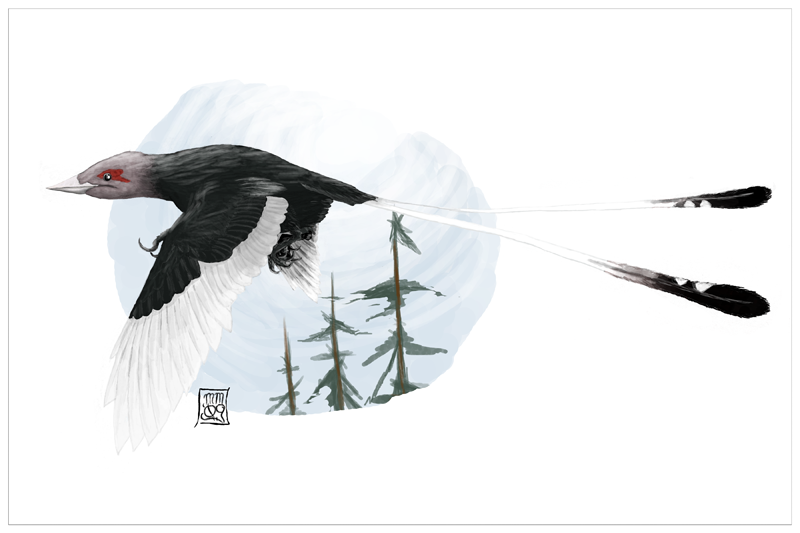home > natural history
Confuciusornis sanctus
"holy Confucius bird"

Click here to buy a print
For 123 years, everything we knew about Mesozoic birds came from three species: Archaeopteryx, Ichthyornis, and Hesperornis (and later, Parahesperornis, spun off from its similar relative). Of those, only Archaeopteryx was close to the origin of birds (the others were much more advanced species from late in the Cretaceous period) and only Archaeopteryx preserved good impressions of feathers (Parahesperornis came with a few feather traces). This status quo changed in 1995 with the description of the second known Mesozoic bird to preserve complete skeletons with complete feather imprints: Confuciusornis sanctus, the tip of the iceberg in the history of vertebrate fossil exploration in the Yixian Formation of China.
Not only were Confuciusornis fossils exquisitely preserved (possibly down to the color patterns in their feathers), there were heaps of them. Though known mainly from a single small region of the Yixian beds, Confuciusornis sanctus is known from literally thousands of complete specimens, making it without a doubt the most completely known Mesozoic bird species. Such high resolution allows a detailed reconstruction and examination of life history and differences between individuals. For example, one distinctive feature of Confuciusornis are the long pintail feathers. Unlike modenr, fan-tailed birds, the tail feathers of Confuciusornis were, mainly, extremely short and ould have given a stubby appearance. However, these feathers are present in less than half of known specimens. Long thought to indicate sexual dimorphism (with only the males possessing ling tail feathers), later studies showed that they probably appeared only in sexually mature individuals of both sexes. The pintail feathers are also unique in thier structure. Most feathers have a central quill or "rachis" down their length and a vane made up of filaments called barbs. In confuciusornithid pintail feathers, however, a rachis and barbs are only present in the tip of the feather. The rest is composed of a solid sheet. These types of feathers are also found in some modern birds, like Birds of Paradise, and in some other Mesozoic birds including Protopteryx and Epidexipteryx, and juveniles of more primitive birds like Similicaudipteryx.
The wings of Confuciusornis were very long, with aerodynamic feathers, indicating that Confuciusornis was manuverable in the air. However, it had a small breastbone, indicating a weak flight stroke, and primitive shoulder configuration that did not allow it to raise its wings above its back. The central shaft of the feathers was also too narrow to have been able to support a powered flight stroke, making it likely that Confuciusornis was a glider, though probably a very advanced one.
The wealth of specimens all come from lake sediments and are often piled close together, indicating that a large flock was killed either on the wing while hunting fish (probably by gasses or ashfall from the periodic volcanic eruptions common to its forested habitat) or while roosting together in overhanging tree branches. While long thought to be an herbivore, discoveries showing the pointed shape of the beak (even curved upward in at least one species, C. dui) indicated it was more lilely a fish eater. This was confirmed with the discovery of a specimen with fish remains in its gullet. Confuciusornis was not adapted to swimming, so it's nearly certain that is fed by gliding low over calm lake surfaces, skimming or dipping for small fish.
When it was done feeding, the reversed first toe (hallux) allowed it to perch in trees, though it could not hop from branch to branch as in modern perching birds. Rather, if it needed to shift position in the tree, it would likely clamber using its large wing claws like a modern Hoatzin.
Image Details:
Media: Graphite and digital: Adobe Photoshop CS3
using WACOM Graphire 3
License:
ALL RIGHTS RESERVED
. These images may not be reproduced without the permission of the artist.
DESCRIPTION
Length: 45cm (1.5ft, excluding feathers)
Wingspan: 0.7m (2.3ft)
Weight: 0.5kg (1.1lbs)
Location: Yixian Formation, Liaoning, China
Time: Aptian age, Lower Cretaceous (125Ma)
CLASSIFICATION
Kingdom: Animalia
Phylum: Chordata
Class: Stem-Aves
Order: Confuciusornithiformes
Family: Confuciusornithidae
Genus: Confuciusornis
Species: C. sanctus
SYSTEMATICS
Sauropsida
Diapsida
Archosauria
Ornithosuchia
Dinosauria
Theropoda
Coelurosauria
Maniraptora
Avialae
Confuciusornithidae
